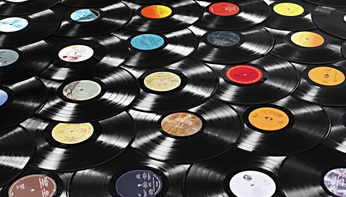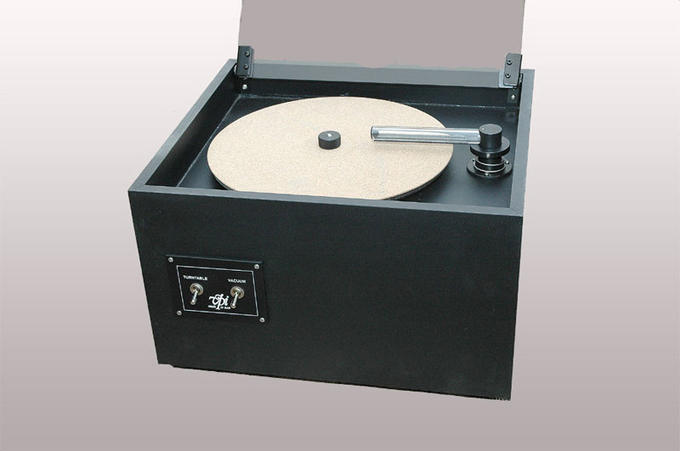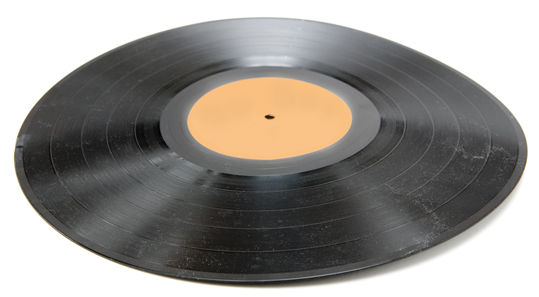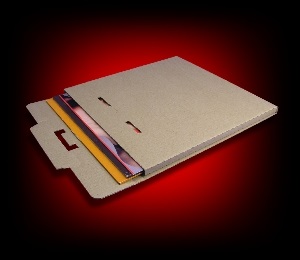 Nearly two years ago a long-time friend of mine and his wife-to-be decided to make some drastic changes in their life. They sold their respective house and moved to a condominium in order to future-proofing themselves (and yes, a future rollator can easily fit in the lift). My friend started to throw away things in an instrumental and unsentimental manner and told me by the way that he considered to drive to the dump with his vinyl collection (of which some had previously belonged to me) due to limited future storage facilities. In these situations you don't think, instinct takes over. I realized that I had to intervene. Without much thought I offered to take care of the disposal of the record collection and sell them. My friend gladly accepted. The first step was to pick up the records. There were a couple of hundreds of LPs, EPs and 12" maxi records in different conditions stored in cardboard boxes (unsorted, of course). The vinyl records had been stored away for many years. The first step was sort them and identify the correct version by identifiers like catalogue number (by using Discogs). This was like paleontology. I made a long list with all information. A record collection says something about a person, see link (opens in a new window) but also how a person progress (or regress) over the years. There were classical, rock, pop, reggae, ska, synth, blues, punk, new wave, funk, soul and even disco records (from my friend's fifteen minutes of fame as a young and aspiring DJ in the late 1970s), but almost no country albums at all. Well, country music is an acquired taste and at the top of the food chain. Some people don't get that far. I have an evidence-based and fact-oriented disposition. I started to read websites and forum threads on the internet for how to proceed. This blog entry is about what I found out, what I have learned, and last but not least, my semi-acid observations from the rabid world of vinyl. The steps for how to proceed can be divided in sorting and stocktaking, cleaning, grading, selling, packaging and shipping. The blog entry (or maybe it's more of a lecture) will end with some concluding remarks. The first step, sorting and stocktaking, has already been described above.
Nearly two years ago a long-time friend of mine and his wife-to-be decided to make some drastic changes in their life. They sold their respective house and moved to a condominium in order to future-proofing themselves (and yes, a future rollator can easily fit in the lift). My friend started to throw away things in an instrumental and unsentimental manner and told me by the way that he considered to drive to the dump with his vinyl collection (of which some had previously belonged to me) due to limited future storage facilities. In these situations you don't think, instinct takes over. I realized that I had to intervene. Without much thought I offered to take care of the disposal of the record collection and sell them. My friend gladly accepted. The first step was to pick up the records. There were a couple of hundreds of LPs, EPs and 12" maxi records in different conditions stored in cardboard boxes (unsorted, of course). The vinyl records had been stored away for many years. The first step was sort them and identify the correct version by identifiers like catalogue number (by using Discogs). This was like paleontology. I made a long list with all information. A record collection says something about a person, see link (opens in a new window) but also how a person progress (or regress) over the years. There were classical, rock, pop, reggae, ska, synth, blues, punk, new wave, funk, soul and even disco records (from my friend's fifteen minutes of fame as a young and aspiring DJ in the late 1970s), but almost no country albums at all. Well, country music is an acquired taste and at the top of the food chain. Some people don't get that far. I have an evidence-based and fact-oriented disposition. I started to read websites and forum threads on the internet for how to proceed. This blog entry is about what I found out, what I have learned, and last but not least, my semi-acid observations from the rabid world of vinyl. The steps for how to proceed can be divided in sorting and stocktaking, cleaning, grading, selling, packaging and shipping. The blog entry (or maybe it's more of a lecture) will end with some concluding remarks. The first step, sorting and stocktaking, has already been described above.
 The second step is cleaning. Before this sales project started I had only cleaned a vinyl record once or twice and then it was very severe cases. If you're going to sell vinyl through some high-profiled sites they will have to be clean, squeaky clean that is. There are two competing schools fighting each other ruthlessly. One school argues that the whole cleaning issue is nonsense. Some lukewarm tap water and mild soap and then air dry naturally will do the trick. The other school is appauled by this. The tap water, although fresh and perfectly good for drinking, is undistilled and contains particles that will affect your vinyls in a negative way. The above-mentioned cleaning method will press grease and dirt into the spiral grooves and in addition it will cause static electricity. The latter school argues that the vinyl must be cleaned with the proper liquides and with the right techniques. There are different cleaning methods, but I chose the often used method which includes diluted 99,5 percent Isopropanol (very flammable), distilled water and micro fiber cloths. When you clean the vinyls, you will have to move the cloth very gently and always in the same direction as the spriral grooves. This methods will effectively clean your vinyl no matter what the other school claim. For once, the manic cleaners seems to be right. The only thing the competing schools agree about is the superior air dry method and avoiding liquid on the label. If you want industrial strength for your cleaning you should consider to obtain a record cleaning machine (RCM), like the VPI Industries H-16.5 (see picture left) which operates with fluid, vacuum suction and brushes. The price of this old model was $450 in 2007. However, there's an influential countermovement and a rise against the machines. The opponents best argument is that nothing beats a human touch.
The second step is cleaning. Before this sales project started I had only cleaned a vinyl record once or twice and then it was very severe cases. If you're going to sell vinyl through some high-profiled sites they will have to be clean, squeaky clean that is. There are two competing schools fighting each other ruthlessly. One school argues that the whole cleaning issue is nonsense. Some lukewarm tap water and mild soap and then air dry naturally will do the trick. The other school is appauled by this. The tap water, although fresh and perfectly good for drinking, is undistilled and contains particles that will affect your vinyls in a negative way. The above-mentioned cleaning method will press grease and dirt into the spiral grooves and in addition it will cause static electricity. The latter school argues that the vinyl must be cleaned with the proper liquides and with the right techniques. There are different cleaning methods, but I chose the often used method which includes diluted 99,5 percent Isopropanol (very flammable), distilled water and micro fiber cloths. When you clean the vinyls, you will have to move the cloth very gently and always in the same direction as the spriral grooves. This methods will effectively clean your vinyl no matter what the other school claim. For once, the manic cleaners seems to be right. The only thing the competing schools agree about is the superior air dry method and avoiding liquid on the label. If you want industrial strength for your cleaning you should consider to obtain a record cleaning machine (RCM), like the VPI Industries H-16.5 (see picture left) which operates with fluid, vacuum suction and brushes. The price of this old model was $450 in 2007. However, there's an influential countermovement and a rise against the machines. The opponents best argument is that nothing beats a human touch.
 The third step is grading. Grading plays an important role when it comes to creating a common framework. The term "very good shape" namely has a quite different meaning for different people. Both vinyls and cds can be graded. It may seem a bit odd to grade cds. I can understand the grading of media condition, the condition of album cover, booklet and back cover. Jewel cases and trays tend to break, but are easily replaced. But some hard-core collectors are only interested in cds with the original cases and trays. And, believe me, they know the difference between original and replaced plastic. This is “authenticity fetishism” at its finest. But now back to the main issue. There are two schools of grading, visual grading and play grading. It's pretty clear from the terms what they mean: visually inspection respective play assessment. The latter method appears to be superior. However, even the play grading varies since source, amplifier and loud speakers vary. I don't have a turntable anymore (the last one was a Thorens) so the choice of grading method was easy. The guiding principle for grading is "The Goldmine Grading System", see link (opens in a new window). The scale from high to low is Mint (M), Near Mint (NM), Very Good Plus (VG+), Very Good (VG), Good Plus (G+), Good (G), Fair (F) and Poor (P). M should be used sparingly as a grade, if at all. NM is the highest price listed in all Goldmine price guides. VG+ is worth 50 percent of the NM value, while F or P is worth 0-5 percent of the NM value. Alongside "The Goldmine Grading System" abbrevations for every possible combination of defects (creases, folds, seam splits, ring wear and sticker residues) have developed. Grading takes about a minute to learn, but a lifetime to fully master. Some purists take pride in declaring their grading as "conservative grading". The effects of grading are simple. If your grading is "correct" or "conservative" in the eyes of the vinyl tribunal you will get positive feedback. If not, you will burn in Hell. There are really no boundaries for the insults, contempt and scorn for an overgrading seller.
The third step is grading. Grading plays an important role when it comes to creating a common framework. The term "very good shape" namely has a quite different meaning for different people. Both vinyls and cds can be graded. It may seem a bit odd to grade cds. I can understand the grading of media condition, the condition of album cover, booklet and back cover. Jewel cases and trays tend to break, but are easily replaced. But some hard-core collectors are only interested in cds with the original cases and trays. And, believe me, they know the difference between original and replaced plastic. This is “authenticity fetishism” at its finest. But now back to the main issue. There are two schools of grading, visual grading and play grading. It's pretty clear from the terms what they mean: visually inspection respective play assessment. The latter method appears to be superior. However, even the play grading varies since source, amplifier and loud speakers vary. I don't have a turntable anymore (the last one was a Thorens) so the choice of grading method was easy. The guiding principle for grading is "The Goldmine Grading System", see link (opens in a new window). The scale from high to low is Mint (M), Near Mint (NM), Very Good Plus (VG+), Very Good (VG), Good Plus (G+), Good (G), Fair (F) and Poor (P). M should be used sparingly as a grade, if at all. NM is the highest price listed in all Goldmine price guides. VG+ is worth 50 percent of the NM value, while F or P is worth 0-5 percent of the NM value. Alongside "The Goldmine Grading System" abbrevations for every possible combination of defects (creases, folds, seam splits, ring wear and sticker residues) have developed. Grading takes about a minute to learn, but a lifetime to fully master. Some purists take pride in declaring their grading as "conservative grading". The effects of grading are simple. If your grading is "correct" or "conservative" in the eyes of the vinyl tribunal you will get positive feedback. If not, you will burn in Hell. There are really no boundaries for the insults, contempt and scorn for an overgrading seller.
 The fourth step is selling. Selling hundreds of LPs, EPs and 12" maxi records separetely would maximize revenues, but would be very time-consuming. After debating myself, I decided to make a compromise. I identified and picked out the most valuable records (LPs, EPs and 12") to be sold separetely in one stack. The rest of the vinyl were then divided into small packages of ten. The divison was based on genre, artists or similar style and included both common albums and rarities. The sorting procedure goes to show of how little you know about the value of vinyl. My conception of the world was turned upside down, since I initially was convinced of that some of the vinyl were really valuable, for example some rare funk albums from the 1970s. However, the market for this genre was non-existent and the value of the albums very low (next to nothing). Other vinyl records, like obscure swedish punk and new wave, were to my surprise priced very high. The next question was where to sell. The largest market is Discogs, but the high shipping cost will deter all but very determined collectors with buying power. Selling on Tradera (swedish Ebay) would lower the shipping cost, but the number of buyers shrinks significantly. After another debate, I decided to make a compromise. Some of the most valuable records were listed for sale on Discogs. Then unsold records on Discogs were listed for sale on Tradera together with all other vinyl. No matter how much time and effort you put in as a seller on detailed descriptions and pictures there will be questions about your items. There are two kinds of questioner. Those who are very interested and eager to buy and those who are very interested, but have no plans whatsoever of buying anything. The buyer-questioner personality is easy to understand. It's not strange or weird to ask additional questions or ask for detailed pictures if you're contemplating to pay top dollar for a rare record. The chatter-questioner personality is harder to understand. The answer to this paradox is that questions and follow-up questions, in addition to the information value, have an important social function. I think everyone who have ever sold anything on internet knows what I'm talking about.
The fourth step is selling. Selling hundreds of LPs, EPs and 12" maxi records separetely would maximize revenues, but would be very time-consuming. After debating myself, I decided to make a compromise. I identified and picked out the most valuable records (LPs, EPs and 12") to be sold separetely in one stack. The rest of the vinyl were then divided into small packages of ten. The divison was based on genre, artists or similar style and included both common albums and rarities. The sorting procedure goes to show of how little you know about the value of vinyl. My conception of the world was turned upside down, since I initially was convinced of that some of the vinyl were really valuable, for example some rare funk albums from the 1970s. However, the market for this genre was non-existent and the value of the albums very low (next to nothing). Other vinyl records, like obscure swedish punk and new wave, were to my surprise priced very high. The next question was where to sell. The largest market is Discogs, but the high shipping cost will deter all but very determined collectors with buying power. Selling on Tradera (swedish Ebay) would lower the shipping cost, but the number of buyers shrinks significantly. After another debate, I decided to make a compromise. Some of the most valuable records were listed for sale on Discogs. Then unsold records on Discogs were listed for sale on Tradera together with all other vinyl. No matter how much time and effort you put in as a seller on detailed descriptions and pictures there will be questions about your items. There are two kinds of questioner. Those who are very interested and eager to buy and those who are very interested, but have no plans whatsoever of buying anything. The buyer-questioner personality is easy to understand. It's not strange or weird to ask additional questions or ask for detailed pictures if you're contemplating to pay top dollar for a rare record. The chatter-questioner personality is harder to understand. The answer to this paradox is that questions and follow-up questions, in addition to the information value, have an important social function. I think everyone who have ever sold anything on internet knows what I'm talking about.
 The fifth step is packaging and shipping. How hard can it be? In fact, it can be very hard if you strive to pack and ship in an inobjectionally manner. Unlike the cd format, vinyls are both fragile and have bulky size, which makes packaging almost an art form. The first rule is to always take out the record placed in its protective sleeve and place it upon the album cover and then pack them together. The reason for this is to avoid ring wear or seam split under transport. The simpliest way to pack is to use two bits of cardboard with slightly larger dimensions than the album sleeve. Then you place the album sleeve in the middle and use packing tape to press each side together, so that the vinyl remains fixed in the package. An experienced packer knows that you should turn one side a quarter vis-a-vis the direction of fibers on the cardboard on the opposite side. The stability of the package hereby increases. You can also use thin bubble wrap, but there are different opinions of the possible benefits of it. The EPs are treated in a similar manner, but shipped in their album cover (since normally there are no protective inner sleeves). Of course, the high priests of vinyl packaging don't use simple cardboard pieces. It's really beneath their dignity. Instead they use German quality cartons from Protected, see picture (right) and a link here (opens in a new window). Despite the high quality the cartons are very affordable. The company Protected offers everything that can be imagined when it comes to taking care of and protecting your music. Shipping is the easy part. Calculate the shipping cost and set the cost. Shipping is quite expensive. In my opinion postal service is a public good and its price should be held at a minimum to promote trade, prosperity and building up record collections. Shipping is also very time-consuming with many recurring visits to the postal outlets. The swedish postal service is very reliable and there were no hitches. I also offered the buyers a pickup alternative. This worked well since most people are reliable.
The fifth step is packaging and shipping. How hard can it be? In fact, it can be very hard if you strive to pack and ship in an inobjectionally manner. Unlike the cd format, vinyls are both fragile and have bulky size, which makes packaging almost an art form. The first rule is to always take out the record placed in its protective sleeve and place it upon the album cover and then pack them together. The reason for this is to avoid ring wear or seam split under transport. The simpliest way to pack is to use two bits of cardboard with slightly larger dimensions than the album sleeve. Then you place the album sleeve in the middle and use packing tape to press each side together, so that the vinyl remains fixed in the package. An experienced packer knows that you should turn one side a quarter vis-a-vis the direction of fibers on the cardboard on the opposite side. The stability of the package hereby increases. You can also use thin bubble wrap, but there are different opinions of the possible benefits of it. The EPs are treated in a similar manner, but shipped in their album cover (since normally there are no protective inner sleeves). Of course, the high priests of vinyl packaging don't use simple cardboard pieces. It's really beneath their dignity. Instead they use German quality cartons from Protected, see picture (right) and a link here (opens in a new window). Despite the high quality the cartons are very affordable. The company Protected offers everything that can be imagined when it comes to taking care of and protecting your music. Shipping is the easy part. Calculate the shipping cost and set the cost. Shipping is quite expensive. In my opinion postal service is a public good and its price should be held at a minimum to promote trade, prosperity and building up record collections. Shipping is also very time-consuming with many recurring visits to the postal outlets. The swedish postal service is very reliable and there were no hitches. I also offered the buyers a pickup alternative. This worked well since most people are reliable.
 And now some concluding remarks. First of all, I thought I had a pretty good knowledge of the market. But after the sorting and stocktaking procedure was completed, I realized that I didn't know much. The prices are mainly determined by the exact release (from almost priceless to almost no price). I also found out that the records you might think are valuable often have no value, while some obscure albums can generate a high prize (depending on the release). Second, cleaning is highly underrated. Not only will the vinyl look better, the sound quality will improve significantly (at least this is what I have read). Third, the grading procedure was a painful reminder of that I have mistreated vinyl in the past. I was aware of this fact, but the full extent wasn't clear until I read the websites and forum threads. For example, piling them upon each other and torturing them with wrong weights on pick-ups, worn-out needles, cheap synthetical brushes etcetera. You should, of course, take good care of your vinyl. The prices are besides the exact release determined by its grading. The grading system is a good thing taken in moderation, but for some vinylists the grading rituals tend to go out of control. They are totally focused on the paper and vinyl quality, and have very little interest the music. This behavior have similarities with audiophilea, see link (opens in a new window) and is close to the second and anal stage in Sigmund Freud's theory of psychosexual development. A friend of mine objected to this comparison and argued that this seemingly obsession could be explained by a simple desire to resell them at a good price. I doubt this. The hard-core vinyl people - like the study objects of Freud - are very reluctant to give up and give away anything. If you have some basic insights in psychology you will understand this ambigious remark. Fourth, the selling part is quite fun. I never had any plans to become a day-trader of vinyls. But I can see the fascination and allure in buying cheap and selling dear. However, this requires both special knowledge and time. I have neither. Fifth, the packaging and shipping part is just tedious and time-consuming. One good thing, however, is that you get pretty good at postal rate tables, spatial thinking applied to cardboard pieces and to assess tape consumption. The bottom line from this project is that I earned a considerable sum on behalf of my friend. But would I do it again? Hardly. All the work blew all time frames by a wide margin. Three months passed between the shipment of the first and the last album. The music always comes first for me. Readers of the article series on the site may also have noted that cd is my preferred format. Many years ago I ditched all my vinyl and went for cd. I'm not going to change format again and certainly not to vinyl. Some people praise vinyl. I'm not one of them. For me vinyl is just too unwieldy and a nostalgic keepsake. It's like bell bottom jeans. You're not interested in them, if you were forced to wear them the first time they were around. The only thing I miss with vinyl is the elaborate album covers, especially the gatefold covers. I can't see there will be anything like this in the future.
And now some concluding remarks. First of all, I thought I had a pretty good knowledge of the market. But after the sorting and stocktaking procedure was completed, I realized that I didn't know much. The prices are mainly determined by the exact release (from almost priceless to almost no price). I also found out that the records you might think are valuable often have no value, while some obscure albums can generate a high prize (depending on the release). Second, cleaning is highly underrated. Not only will the vinyl look better, the sound quality will improve significantly (at least this is what I have read). Third, the grading procedure was a painful reminder of that I have mistreated vinyl in the past. I was aware of this fact, but the full extent wasn't clear until I read the websites and forum threads. For example, piling them upon each other and torturing them with wrong weights on pick-ups, worn-out needles, cheap synthetical brushes etcetera. You should, of course, take good care of your vinyl. The prices are besides the exact release determined by its grading. The grading system is a good thing taken in moderation, but for some vinylists the grading rituals tend to go out of control. They are totally focused on the paper and vinyl quality, and have very little interest the music. This behavior have similarities with audiophilea, see link (opens in a new window) and is close to the second and anal stage in Sigmund Freud's theory of psychosexual development. A friend of mine objected to this comparison and argued that this seemingly obsession could be explained by a simple desire to resell them at a good price. I doubt this. The hard-core vinyl people - like the study objects of Freud - are very reluctant to give up and give away anything. If you have some basic insights in psychology you will understand this ambigious remark. Fourth, the selling part is quite fun. I never had any plans to become a day-trader of vinyls. But I can see the fascination and allure in buying cheap and selling dear. However, this requires both special knowledge and time. I have neither. Fifth, the packaging and shipping part is just tedious and time-consuming. One good thing, however, is that you get pretty good at postal rate tables, spatial thinking applied to cardboard pieces and to assess tape consumption. The bottom line from this project is that I earned a considerable sum on behalf of my friend. But would I do it again? Hardly. All the work blew all time frames by a wide margin. Three months passed between the shipment of the first and the last album. The music always comes first for me. Readers of the article series on the site may also have noted that cd is my preferred format. Many years ago I ditched all my vinyl and went for cd. I'm not going to change format again and certainly not to vinyl. Some people praise vinyl. I'm not one of them. For me vinyl is just too unwieldy and a nostalgic keepsake. It's like bell bottom jeans. You're not interested in them, if you were forced to wear them the first time they were around. The only thing I miss with vinyl is the elaborate album covers, especially the gatefold covers. I can't see there will be anything like this in the future.
